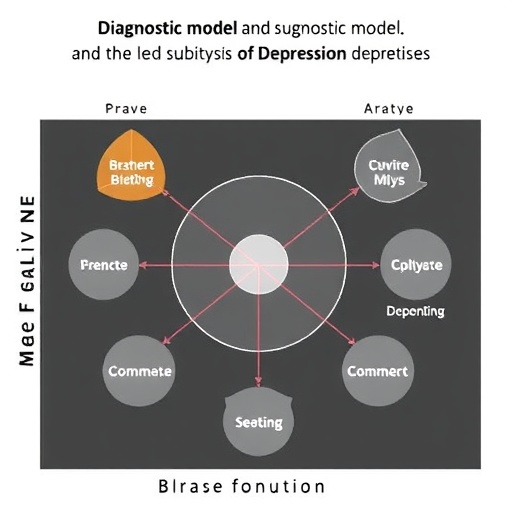In a groundbreaking study published in BMC Psychiatry, researchers have unveiled a sophisticated diagnostic model for major depressive disorder (MDD) centered on the intricate role of PANoptosis-related genes. This novel work elevates our understanding of MDD pathogenesis by focusing on PANoptosis, a recently characterized form of programmed cell death that integrates components of pyroptosis, apoptosis, and necroptosis. The findings not only reveal critical molecular players driving disease manifestation but also pave the way for personalized treatment strategies based on molecular subtypes.
MDD is among the most debilitating neuropsychiatric disorders worldwide, with complex etiology and heterogeneous clinical presentations complicating diagnosis and treatment. Despite advances, the biological underpinnings of MDD remain elusive. Emerging evidence implicates immune dysregulation and inflammatory pathways, but direct connections to specific forms of cell death, like PANoptosis, have only recently gained attention.
Exploiting the extensive gene expression dataset GSE98793, the research team embarked on a comprehensive bioinformatics exploration to identify differentially expressed genes associated with PANoptosis in patients diagnosed with MDD. This dataset provided a robust platform for identifying genetic signatures that differentiate MDD patients from healthy controls, focusing specifically on PANoptosis-related genes (PRGs) to unravel underlying molecular dysfunctions.
Through rigorous computational pipelines, the investigators pinpointed eight key PANoptosis genes—TRAF1, TNFSF13, TLR2, SH2D1A, RNF144B, ICAM1, HK2, and ADA—that collectively exhibited significant dysregulation in MDD cases. Each gene’s functional role converges on immune signaling pathways, inflammation modulation, and cell death mechanisms, highlighting their potential impact on neural integrity and mood regulation.
Subsequent Gene Ontology and KEGG enrichment analyses added layers of insight, revealing that these PANoptosis-associated genes predominantly influence cellular stress responses, immune activation, and metabolic processes—pathways long suspected to be critical in neuropsychiatric disease progression. This integration of bioinformatics with functional annotation underscores the multifaceted role of PANoptosis in brain pathology.
To further refine the clinical relevance, the study employed advanced machine learning techniques, including Random Forest and LASSO regression analyses, to construct a diagnostic model. This model demonstrated high predictive accuracy in classifying MDD patients based on the expression profiles of PANoptosis key genes, suggesting that such molecular signatures could revolutionize MDD diagnostics by enabling early and reliable detection.
Moreover, immune infiltration analysis added another dimension by showing that distinct immune cell populations correlate with the expression of these key genes in MDD patients. Particularly, two molecularly stratified subtypes emerged, designated cluster 1 and cluster 2, each exhibiting unique immune landscape features. Such stratification offers promising avenues for personalized medicine approaches targeting immune pathways differentially involved in each subtype.
Strikingly, the genes RNF144B and HK2 stood out due to their notable upregulation and their established roles in promoting neutrophil activity, a critical component of innate immunity. This finding strengthens the hypothesis that aberrant neutrophil-driven inflammation may be a driving force in the pathophysiology of depressive disorders, pointing to potential therapeutic targets.
To validate their in silico findings, the research team conducted quantitative real-time PCR (qRT-PCR) on clinical samples, confirming the elevated expression of the identified key genes in MDD patients compared to controls. This empirical reinforcement bolsters confidence in the robustness of the diagnostic model and its biological relevance.
The implications of this study are profound. By elucidating the connection between PANoptosis and immune dysregulation in MDD, the research offers a mechanistic framework linking cell death pathways to neuropsychiatric symptoms. This paradigm shift could inform future therapeutic development, emphasizing interventions that modulate PANoptosis-related signaling cascades to ameliorate depressive symptoms.
Importantly, the identification of molecularly distinct subtypes within MDD highlights the heterogeneity inherent in the disorder. Such stratification may explain the variable treatment responses observed clinically and encourages the design of subtype-specific therapeutic regimens that improve outcomes and reduce trial-and-error prescribing.
In summary, this cutting-edge study merges bioinformatics, molecular biology, and translational research to chart new territory in psychiatric diagnostics. By focusing on PANoptosis key genes, the authors provide compelling evidence for immune-centric, cell death-dependent mechanisms underlying MDD and establish an innovative model capable of both diagnosing and subtyping this complex disorder.
As the field moves forward, integrating these molecular insights with clinical data could enable the development of precision psychiatry tools, transforming how MDD is diagnosed and treated. The prospect of employing PANoptosis-related biomarkers in clinical settings heralds a new era in mental health care where biological heterogeneity is acknowledged and addressed directly.
Overall, this research propels the understanding of MDD beyond traditional neurotransmitter hypotheses, highlighting the crucial interplay between immune processes, cell death, and psychiatric disease. The findings invite further investigation into therapeutic agents targeting PANoptosis pathways, potentially offering novel antidepressant modalities and improving life quality for millions affected by MDD globally.
Subject of Research: Major depressive disorder; PANoptosis-related genes; molecular diagnostics; immune dysregulation; neuropsychiatric disorders.
Article Title: Construction of diagnostic model and subtype analysis of major depressive disorder based on PANoptosis key genes.
Article References:
Zhang, H., Huang, N., Ma, X. et al. Construction of diagnostic model and subtype analysis of major depressive disorder based on PANoptosis key genes. BMC Psychiatry 25, 929 (2025). https://doi.org/10.1186/s12888-025-07397-9
Image Credits: AI Generated




